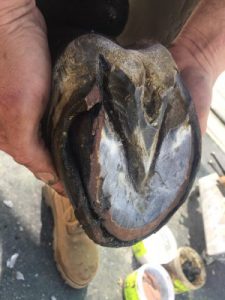Combating White Line Disease
Every farrier or horse owner is unfortunately familiar with white line disease. Contributing factors vary widely from nutritional and mechanical to environmental, but whatever the imbalance, the microbes which are always present in some form in the hoof, proliferate out of balance leading to what we know as white line disease.
 The white line in a horse’s hoof is present only when barefoot which is why a good farrier is usually the first to identify the disease. A healthy white line is solid from heel to heel and is “waxy” white in color. An unhealthy white line will be black and striated (see associated image). White line disease, presents as a separation of the wall and the sole as fungus and bacteria eat away at the layers of the hoof wall. White line disease is a generic name for this insidious condition also called wall thrush, seedy toe and hollow foot. The true issue is not in the white line but in the deepest portion known as the non-pigmented stratum medium. White line disease caused by an active anaerobic bacterium mostly present in the toe and quarters of the hoof.
The white line in a horse’s hoof is present only when barefoot which is why a good farrier is usually the first to identify the disease. A healthy white line is solid from heel to heel and is “waxy” white in color. An unhealthy white line will be black and striated (see associated image). White line disease, presents as a separation of the wall and the sole as fungus and bacteria eat away at the layers of the hoof wall. White line disease is a generic name for this insidious condition also called wall thrush, seedy toe and hollow foot. The true issue is not in the white line but in the deepest portion known as the non-pigmented stratum medium. White line disease caused by an active anaerobic bacterium mostly present in the toe and quarters of the hoof.
White line disease is treated by debriding the area, exposing the fungus and bacteria to air when oxygen is its worst enemy. There are several commercial, topical ointments that have shown great success in addition to debridement.
One Respond Systems’ customer, Karen Gould from California, found herself with a case of white line disease on her hands that went undiagnosed by a previous farrier. She credits her current farrier, the diligent Nathan Zacharias from the San Diego County area of California, with successfully treating the disease. This is their treatment timeline and technique. And just like many cases of white line, there were some treatments that lent to greater success than others.
The more information that is out there about treatment options and cases, once reviewed and analyzed, can help lead to faster recovery for others faced with the same situation down the line.
As always, consult with your veterinarian for proper diagnosis, treatment recommendations and medications before commencing any therapy program.
Timeline and Treatment:
– At the end of March 2018, Karen found out her horse had white line disease that went up about two inches from the toe.
– Cleaned thrush out and commenced peroxide twice a day into the separation until foaming stopped. Horse continued to be lame
– Lots of heat in foot.
– Started laser treatment with 2400XL Respond Systems laser using the Ultra-Wide, Super-Pulse Head. 20 min per treatment, twice a day.
– Commenced daily Empson salt soaks to address the continued heat in the hoof and draw out the infection
– Applies fungicide into separation area
– Continuing to laser twice a day to coronary band as well to stimulate new growth. Either on F6 or F3 if the area is super sensitive and hot.
– Farrier packed it with fungicides, copper sulfate, then hawthorn hoof packing, dental impression material (DIM) and pad.
– Pocket of separation had DECREASED from a week prior. Both the vet and the farrier seemed surprised at the positive progress
– Swelling is gone. No heat in hoof and horse moving soundly and willingly.
– Still lasering 5x per week including the coronary band.
Laser therapy was one part of a full treatment program to combat white line. In this specific case, as in all cases where bacteria, virus or fungi are present, laser therapy cannot kill the offending culprit. A multi-faceted approach using topicals, pharmaceuticals and natural remedies is required to conquer the disease-causing agent. Laser therapy comes into play by helping to reduce the inflammation and accelerate healing through a cascade of biochemical pathways that enable the body to fight back faster and reduce complications that lead to more severe lameness. Laser therapy can help the other agents involved in the treatment plan work faster and more effectively. The continued use of laser therapy after the condition has cleared up stimulates new, healthy growth of the hoof.

